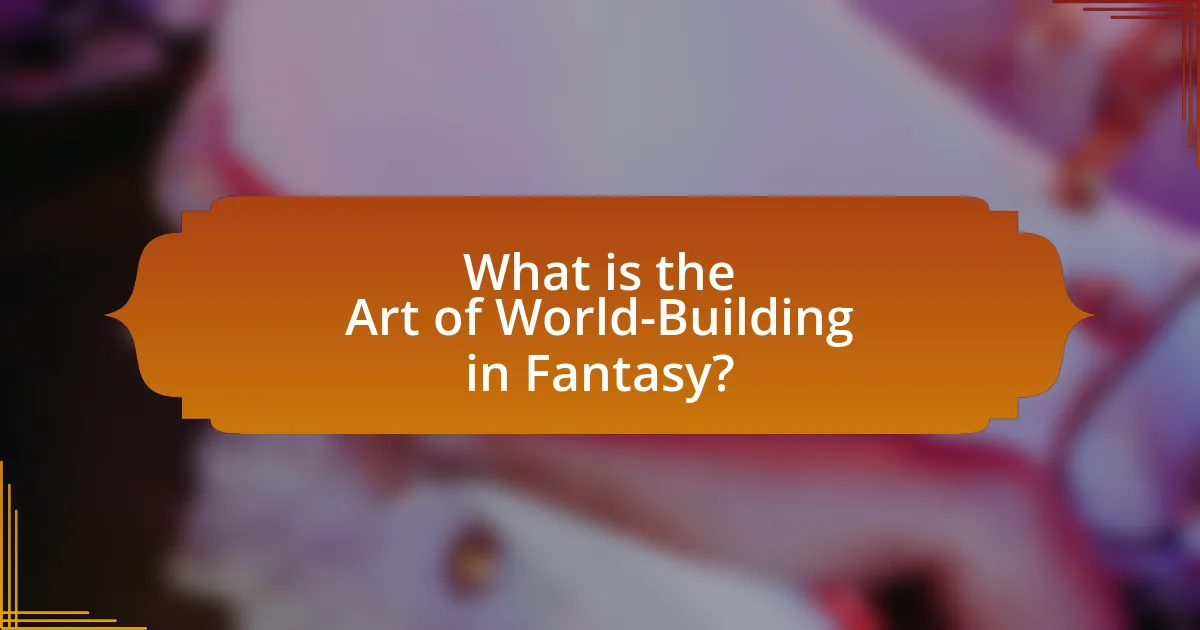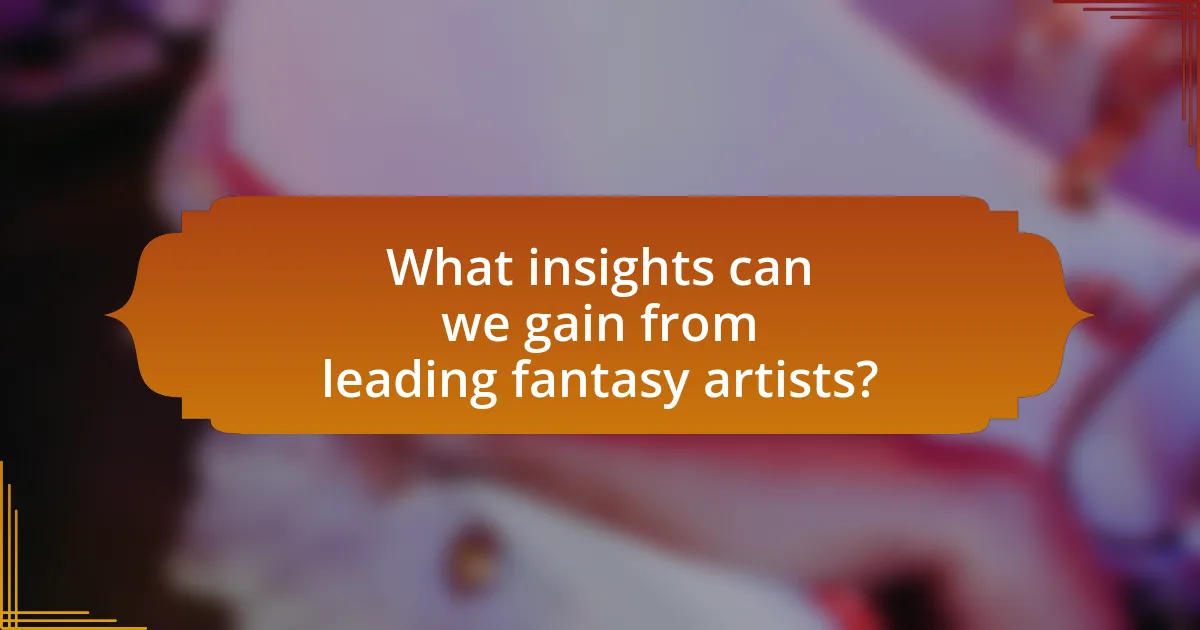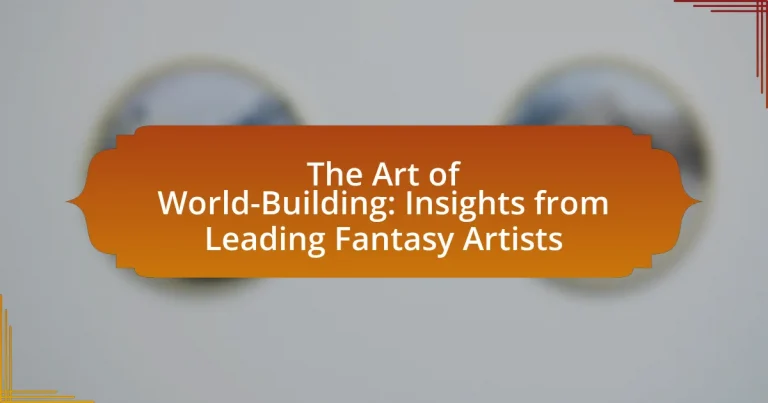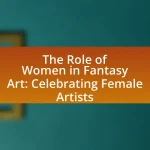The article “The Art of World-Building: Insights from Leading Fantasy Artists” explores the intricate process of creating immersive fictional universes in fantasy literature and art. It highlights the essential elements of effective world-building, including detailed settings, coherent histories, distinct cultures, and consistent systems of rules. The article also examines how world-building enhances storytelling, influences character development, and engages readers, while providing insights from renowned fantasy artists on techniques and best practices. Additionally, it addresses common challenges and mistakes in world-building, offering practical tips and resources for aspiring artists to improve their skills.

What is the Art of World-Building in Fantasy?
The art of world-building in fantasy involves creating a detailed and immersive fictional universe that enhances storytelling. This process includes developing unique cultures, histories, geographies, and systems of magic or technology that contribute to the narrative’s depth. Successful world-building is evident in works like J.R.R. Tolkien’s Middle-earth, which features intricate languages, histories, and social structures, making the setting feel real and lived-in. Additionally, authors like George R.R. Martin in “A Song of Ice and Fire” demonstrate how political dynamics and geography shape character motivations and plot developments, further validating the importance of comprehensive world-building in engaging readers.
How do leading fantasy artists define world-building?
Leading fantasy artists define world-building as the comprehensive process of creating an immersive and believable universe that includes its own rules, cultures, and histories. This definition emphasizes the importance of detail and consistency in crafting environments that resonate with audiences, allowing them to engage deeply with the narrative. For instance, renowned artists like Brian Froud and Alan Lee have illustrated that effective world-building involves not only visual elements but also the integration of lore and character development, which enhances the overall storytelling experience. Their works demonstrate that a well-constructed world can evoke emotions and spark imagination, making it a crucial aspect of fantasy art.
What are the key elements that constitute effective world-building?
Effective world-building consists of several key elements: a well-defined setting, a coherent history, distinct cultures, and a consistent system of rules. The setting provides the physical and geographical context, influencing the narrative and character interactions. A coherent history establishes the timeline and events that shape the world, giving depth and realism. Distinct cultures introduce diverse societies, beliefs, and customs, enriching the narrative and character development. Lastly, a consistent system of rules, whether magical, technological, or societal, ensures that the world operates logically, maintaining immersion for the audience. These elements collectively create a believable and engaging world that enhances storytelling.
How does world-building enhance storytelling in fantasy?
World-building enhances storytelling in fantasy by creating immersive environments that engage readers’ imaginations and provide context for character actions and plot developments. Detailed settings, such as unique cultures, histories, and geographies, allow for richer narratives and deeper emotional connections. For instance, J.R.R. Tolkien’s Middle-earth, with its intricate languages and histories, not only serves as a backdrop but also influences character motivations and conflicts, making the story more compelling. This depth of world-building fosters a sense of realism and believability, which is essential for readers to suspend disbelief and fully invest in the narrative.
Why is world-building important in fantasy art?
World-building is crucial in fantasy art because it creates a cohesive and immersive environment that enhances storytelling. A well-developed world provides context for characters, plots, and themes, allowing artists to convey deeper narratives through visual elements. For instance, the intricate landscapes and cultures depicted in works like J.R.R. Tolkien’s Middle-earth or George R.R. Martin’s Westeros not only enrich the visual experience but also engage the audience’s imagination, making the art more impactful. This connection between world-building and narrative depth is supported by studies in visual storytelling, which emphasize that detailed settings can significantly influence viewer engagement and emotional response.
What role does world-building play in character development?
World-building significantly influences character development by providing a contextual framework that shapes characters’ motivations, behaviors, and interactions. In a well-constructed world, the setting, culture, and societal norms inform how characters respond to challenges and relationships, thereby deepening their complexity. For instance, in J.R.R. Tolkien’s Middle-earth, the diverse cultures and histories of races like Elves and Dwarves create distinct character traits and conflicts, illustrating how the environment directly impacts character arcs. This interplay between world-building and character development enhances narrative depth and reader engagement, as characters become more relatable and their journeys more meaningful within the context of their world.
How does world-building influence the reader’s experience?
World-building significantly enhances the reader’s experience by creating immersive environments that engage the imagination. When authors develop detailed settings, including unique cultures, histories, and geographies, they provide readers with a rich context that deepens emotional investment in the narrative. For instance, J.R.R. Tolkien’s Middle-earth, with its intricate languages and lore, allows readers to feel as though they are part of a living world, which can lead to a more profound connection to the characters and plot. Studies in literary analysis indicate that well-constructed worlds can increase reader satisfaction and retention, as they encourage exploration and curiosity about the narrative universe.

What techniques do leading fantasy artists use in world-building?
Leading fantasy artists utilize techniques such as detailed lore creation, visual storytelling, and immersive environment design in world-building. Detailed lore creation involves developing rich histories, cultures, and mythologies that provide depth to the world, as seen in the works of J.R.R. Tolkien, who crafted extensive backstories for Middle-earth. Visual storytelling is employed through illustrations that convey emotions and narratives, allowing viewers to engage with the world visually, a technique effectively used by artists like Brian Froud. Immersive environment design focuses on creating believable landscapes and settings that enhance the narrative, exemplified by the intricate worlds depicted in video games like “The Elder Scrolls,” where artists meticulously design every aspect of the environment to support the story. These techniques collectively contribute to creating compelling and believable fantasy worlds.
How do artists create immersive environments?
Artists create immersive environments by integrating sensory elements such as visuals, sounds, and textures to engage the audience fully. They utilize techniques like spatial design, interactive installations, and narrative storytelling to transport viewers into a different world. For instance, renowned artist Olafur Eliasson employs light and water to create atmospheric experiences that alter perception, while immersive art experiences like TeamLab’s digital installations blend technology and art to create interactive environments that respond to audience movements. These methods demonstrate how artists can effectively craft spaces that captivate and involve participants, enhancing the overall experience of the artwork.
What tools and mediums are commonly used in fantasy art?
Fantasy art commonly utilizes digital tools, traditional painting mediums, and mixed media techniques. Digital tools include software like Adobe Photoshop and Procreate, which allow for extensive manipulation and layering of images. Traditional painting mediums often involve acrylics, watercolors, and oils, enabling artists to create rich textures and vibrant colors. Mixed media techniques combine various materials, such as ink, collage, and pastels, to enhance visual storytelling. These tools and mediums are essential for artists to effectively convey imaginative worlds and characters, as evidenced by the prevalence of digital art in contemporary fantasy illustrations and the enduring popularity of traditional painting in fantasy art exhibitions.
How do color palettes and textures contribute to world-building?
Color palettes and textures significantly enhance world-building by establishing mood, conveying themes, and creating immersive environments. A carefully chosen color palette can evoke specific emotions; for instance, warm colors like reds and oranges can suggest warmth or danger, while cool colors like blues and greens can imply tranquility or sadness. Textures add depth and realism, making environments feel tangible and lived-in. For example, rough textures can indicate decay or age, while smooth surfaces may suggest modernity or cleanliness. Together, these elements help to visually narrate the story and culture of a world, guiding the audience’s perception and emotional response. This is evident in successful fantasy works, where distinct color schemes and textures are employed to differentiate cultures and settings, enhancing the overall narrative experience.
What narrative techniques are employed in world-building?
Narrative techniques employed in world-building include detailed descriptions, character perspectives, and cultural elements. Detailed descriptions create vivid imagery of the setting, allowing readers to visualize the world. Character perspectives provide insights into the world through the eyes of different characters, enhancing emotional engagement and relatability. Cultural elements, such as language, traditions, and social structures, establish the uniqueness of the world and contribute to its depth. These techniques are essential for immersing readers in a believable and engaging narrative, as evidenced by successful works like J.R.R. Tolkien’s “The Lord of the Rings,” which utilizes rich descriptions and diverse cultures to create a compelling fantasy world.
How do artists integrate lore and history into their worlds?
Artists integrate lore and history into their worlds by creating detailed backstories and cultural contexts that inform the settings, characters, and narratives within their works. This integration often involves researching historical events, mythologies, and cultural practices to develop a rich tapestry that enhances the believability and depth of the fictional universe. For example, J.R.R. Tolkien drew heavily from Norse and Anglo-Saxon mythology to construct the lore of Middle-earth, which includes languages, histories, and intricate relationships between races. This method not only provides authenticity but also allows audiences to connect emotionally with the world, as they can recognize familiar themes and archetypes rooted in real history.
What storytelling methods enhance visual world-building?
Storytelling methods that enhance visual world-building include immersive descriptions, character-driven narratives, and the use of symbolism. Immersive descriptions create vivid imagery that allows readers to visualize the setting, as seen in J.R.R. Tolkien’s detailed landscapes in “The Lord of the Rings.” Character-driven narratives deepen the connection between the audience and the world, exemplified by George R.R. Martin’s “A Song of Ice and Fire,” where character perspectives reveal the intricacies of the world. Additionally, symbolism can convey deeper meanings and themes, as demonstrated in the use of the One Ring as a symbol of power and corruption in Tolkien’s work. These methods collectively enrich the visual experience and understanding of the fictional world.

What insights can we gain from leading fantasy artists?
Leading fantasy artists provide insights into the intricacies of world-building, emphasizing the importance of cohesive narratives and visual storytelling. Their work illustrates how detailed environments, character design, and thematic elements contribute to immersive experiences. For example, artists like Brian Froud and Julie Bell showcase the significance of blending imagination with realism, as seen in Froud’s intricate creature designs and Bell’s dynamic compositions. These artists demonstrate that effective world-building requires a deep understanding of cultural influences, historical contexts, and emotional resonance, which can enhance the believability and engagement of fantasy worlds.
What are the common challenges faced in world-building?
Common challenges faced in world-building include maintaining consistency, developing a believable history, and creating relatable characters. Consistency is crucial as discrepancies can break immersion; for instance, J.R.R. Tolkien meticulously crafted the languages and cultures of Middle-earth to ensure coherence throughout his works. Developing a believable history requires a deep understanding of how societies evolve, which can be complex, as seen in George R.R. Martin’s “A Song of Ice and Fire,” where intricate political histories shape character motivations. Lastly, creating relatable characters is essential for audience connection; characters must reflect human emotions and experiences, a challenge that authors like Brandon Sanderson address by grounding fantastical elements in real-world issues.
How do artists overcome creative blocks in their world-building process?
Artists overcome creative blocks in their world-building process by employing various techniques such as brainstorming, engaging in free writing, and seeking inspiration from diverse sources. These methods allow artists to generate new ideas and perspectives, breaking the mental barriers that hinder creativity. For instance, a study published in the Journal of Creative Behavior found that engaging in free writing can significantly enhance creative output by allowing thoughts to flow without self-censorship. Additionally, collaborating with other artists or participating in workshops can provide fresh insights and motivation, further aiding in overcoming creative stagnation.
What mistakes should be avoided in world-building?
Common mistakes to avoid in world-building include inconsistency in rules, lack of depth in cultures, and neglecting character motivations. Inconsistency can confuse readers and undermine the believability of the world; for example, if magic has specific rules, breaking them without explanation can disrupt immersion. A lack of depth in cultures can lead to stereotypes or one-dimensional societies, which fail to engage readers; detailed histories, traditions, and social structures enhance realism. Additionally, neglecting character motivations can result in unrelatable or flat characters, as their actions should reflect the world’s influences and their personal goals. These mistakes can detract from the overall narrative and reader engagement.
What best practices can aspiring artists learn from professionals?
Aspiring artists can learn the best practice of consistent practice and skill development from professionals. Professionals often dedicate significant time to honing their craft through regular drawing, painting, or digital art creation, which leads to improved techniques and a unique style. For instance, renowned fantasy artist Greg Rutkowski emphasizes the importance of daily practice, stating that it allows artists to experiment and refine their skills over time. Additionally, professionals advocate for seeking constructive feedback, as it helps artists identify areas for improvement and fosters growth. This approach is supported by studies showing that artists who actively seek critique tend to develop their skills more rapidly than those who do not.
How can collaboration enhance the world-building process?
Collaboration enhances the world-building process by integrating diverse perspectives and expertise, which leads to richer and more nuanced settings. When multiple creators contribute, they bring unique ideas, cultural insights, and artistic styles that can deepen the complexity of the world being built. For instance, in collaborative projects like tabletop role-playing games, teams often include writers, artists, and game designers, each adding layers of detail that create a more immersive experience. This collective input can result in innovative concepts that a single creator might overlook, ultimately enriching the narrative and visual elements of the world.
What resources are recommended for improving world-building skills?
Books such as “The Writer’s Guide to Creating a Science Fiction Universe” by George H. Scithers and “World-Building: A Writer’s Guide to Constructing Star Systems and Life-Supporting Planets” by Stephen L. Gillett are recommended for improving world-building skills. These resources provide structured approaches and practical exercises that enhance the understanding of creating immersive worlds. Additionally, online platforms like World Anvil offer tools and community support for writers to develop their settings collaboratively, while courses on platforms like MasterClass feature insights from established authors, providing real-world examples and techniques for effective world-building.
What practical tips can enhance your world-building skills?
To enhance your world-building skills, focus on creating detailed maps and histories for your fictional settings. Detailed maps provide a visual representation of your world, helping to establish geography, culture, and political boundaries, which are essential for consistency in storytelling. Historical context enriches the narrative by giving depth to characters and societies, allowing readers to understand motivations and conflicts. For instance, J.R.R. Tolkien’s Middle-earth features extensive maps and a rich history that contribute significantly to its immersive quality. This approach not only aids in coherence but also engages readers by making the world feel lived-in and authentic.


